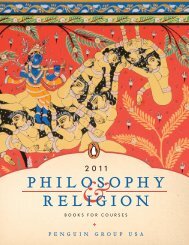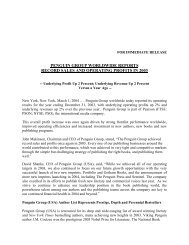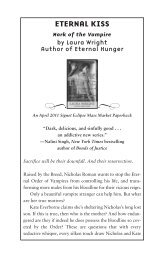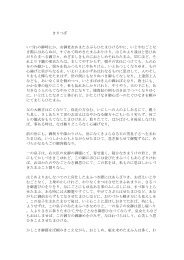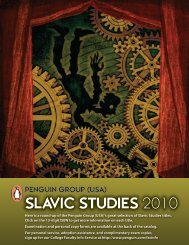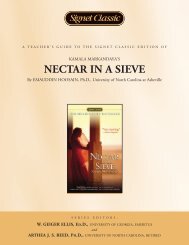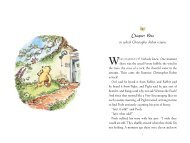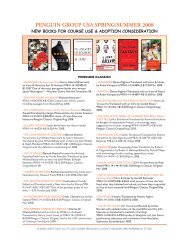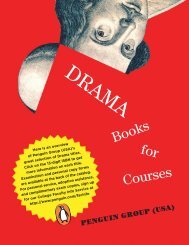The Pearl - Penguin Group
The Pearl - Penguin Group
The Pearl - Penguin Group
Create successful ePaper yourself
Turn your PDF publications into a flip-book with our unique Google optimized e-Paper software.
A TEACHER’S GUIDE TO THE PENGUIN EDITION OF<br />
JOHN STEINBECK’S<br />
THE PEARL<br />
By ARTHEA J. S. REED, PH.D.<br />
SERIES EDITORS:<br />
W. GEIGER ELLIS, ED.D., UNIVERSITY OF GEORGIA, EMERITUS<br />
and<br />
ARTHEA J. S. REED, PH.D., UNIVERSITY OF NORTH CAROLINA, RETIRED
A Teacher’s Guide to John Steinbeck’s <strong>The</strong> <strong>Pearl</strong> 2<br />
NOTE TO THE TEACHER<br />
This guide is designed to assist teachers in moving students beyond the surface story of Steinbeck’s novella. <strong>The</strong> prereading<br />
activities prepare students for what they will read in the novel. <strong>The</strong> brief discussion of the techniques of plot, character<br />
development and theme employed by Steinbeck in his deceptively simple story provides an overview of the story as well<br />
as an understanding of its simplicity and complexity. <strong>The</strong> teaching methodologies are based on response strategies that<br />
encourage student interaction with the literary work. Teachers are encouraged to guide, help with reading, and yet allow<br />
the students to independently respond to the work.<br />
INTRODUCTION<br />
John Steinbeck is one of the greatest storytellers of the twentieth century. His wonderful novellas <strong>The</strong> <strong>Pearl</strong>, Cannery Row,<br />
<strong>The</strong> Red Pony, and Of Mice and Men not only introduce readers to a fascinating, realistic cast of characters, make the hills<br />
and seacoast of California and Mexico come to life, but also tell intriguing stories of the lives of real people. Steinbeck’s<br />
characters are not the rich men and women of California’s boom days, but are the homeless, the migrant workers, the<br />
poor fishermen, and the farmers. However, each of these people has a deceptively simple, but important story to tell, a<br />
story filled with love and pain. <strong>The</strong> stories tell us not only of the lives of the poor who seek to live off the land, but of the<br />
struggles of all people.<br />
<strong>The</strong> <strong>Pearl</strong> is the most teachable of all John Steinbeck’s novellas. <strong>The</strong> story is simple but exciting. However, within its simplicity<br />
is the great complexity of a tale filled with imagery, symbolism, and thematic significance.<br />
BEFORE READING THE NOVEL<br />
This novella needs little introduction. <strong>The</strong> plot itself is quite simple. However, some limited prereading information might<br />
be useful to students not familiar with the oral tradition from which this story comes.<br />
1. It is helpful for teachers to explain the oral storytelling tradition from which this type of story comes. If you live in a part<br />
of the country in which storytelling is or was a part of the culture, it may be possible to orally read or learn to tell one or<br />
more of the “local” stories. Students can discuss these in terms of their surface meaning and also in terms of any messages<br />
or morals they held for the listener.<br />
2. Prior to reading the story, teachers should make it clear to students that Steinbeck moves this tale a step beyond the<br />
storytelling tradition. In the told story the message or moral heard by the listener is likely to have been quite different<br />
from the message contemporary readers get from this story. Teachers can read Steinbeck’s brief introduction to the<br />
students, and ask them: What is a parable? What examples do you know of parables? How does what Steinbeck suggests<br />
here (“everyone takes his own meaning from it and reads his own life into it”) differ from the traditional interpretation<br />
of a parable? Teachers can alert students to listen or read for the moral that would have been heard by villagers as they<br />
listened to this story of the pearl and the fisherman who found it.<br />
WHILE READING THE NOVEL<br />
Students must first understand the simple plot line of the tale before they enjoy its symbolic and thematic significance.<br />
So that students can take their own meaning from the story, it is essential to help them outline the surface story.<br />
THE PLOT<br />
Coyotito, the baby of Kino, a poor Mexican fisherman, and Juana, his mate, is bitten by a scorpion. Juana sucks the<br />
scorpion poison from Coyotito’s wound. When the baby falls ill, the grief-stricken parents take him to the only doctor in<br />
the neighboring town who refuses to treat him because the baby’s parents cannot pay. <strong>The</strong>y wrap Coyotito in a blanket<br />
and take him in their prized canoe into the water so Kino can dive for pearls. Kino finds the “<strong>Pearl</strong> of the World,” and<br />
Coyotito rests more comfortably, the poison receding from his body. Kino believes the great pearl is his baby’s ticket to<br />
health, an education, and a better life. Juana looks forward to being able to be married in the church now that they can<br />
pay. However, superstitions of the village begin to make Juana fear that the pearl is evil and will bring them grief. <strong>The</strong><br />
parish priest who had never had time for Kino and Juana before comes to see the pearl and tells Kino, “I hope thou wilt
A Teacher’s Guide to John Steinbeck’s <strong>The</strong> <strong>Pearl</strong> 3<br />
remember to give thanks, my son, to Him who has given thee this treasure, and to pray for his guidance in the future.”<br />
Juana’ fear of the pearl’s evil power is confirmed after the doctor learns of Kino’s good fortune and comes to treat the baby,<br />
giving him “medication” that makes him very ill. Kino begins to fear, hides the pearl, readies his knife, and stabs a man<br />
who attempts to enter his cabin in the night. Juana begs Kino to throw the evil pearl away before it destroys them.<br />
<strong>The</strong> next morning Kino, Juana, and Coyotito, followed by the villagers, go to La Paz to sell the pearl. Juan Tomas, Kino’s<br />
brother, cautions him to be careful he is not cheated. When Kino presents the pearl to the dealers they tell him it is too<br />
large to sell. Finally, one of the dealers offers Kino a paltry sum. Knowing he is being cheated, Kino takes his pearl, and<br />
with the procession, returns defeated to his village. He buries the pearl, fears that it will be stolen, and decides to travel<br />
many miles on foot to the capital to attempt to sell the pearl. Juana, fearing the evil of the pearl, attempts to throw it away<br />
while Kino sleeps, but Kino chases her and beats her. As Kino walks away from Juana, he kills a man attempting to steal<br />
the pearl, and Juana knows “the old life was gone forever.” <strong>The</strong>y plan to use Kino’s prized possession, the canoe, to begin<br />
their journey to the capital, but Kino finds it with a splintered hole broken in it.” Juana returns to their brush house to<br />
get Coyotito and finds it in flames. Knowing he has killed a man, Kino takes Juana and Coyotito and hides in Juan Tomas’<br />
house, asking him to tell the villagers they were killed in the fire and the pearl was stolen. <strong>The</strong>y flee the village “in the<br />
dark of the moon” relying on the wind to cover their tracks.<br />
All night they walk; by day they hide in the shade of a tree. Juana does not sleep and Kino sleeps fitfully. Waking from a dream,<br />
he tells Juana to quiet the baby because he hears something. In the distance, he sees three men, two on foot and one on<br />
horseback. <strong>The</strong>y pass the family by, but Kino knows the trackers will return. <strong>The</strong> family flees into the mountains, hoping<br />
they can lose them. Near a pool of water, Kino hides Juana and Coyotito in a cave. Finally, the trackers come and make<br />
camp near the pool. <strong>The</strong> baby whimpers, a match flares at the trackers’ campsite, the match dies, Kino sees a rifle near<br />
the tracker and readies himself to steal it. But, before he reaches the tracker the moon rises, casting too much light on the<br />
camp site. Kino prepares to leap for the gun as Coyotito whimpers in the distance. He is able to kill two of the trackers.<br />
But, when he hears Juana’s cry he knows it is the cry of death for her baby. Kino carries the rifle and Juana carries the dead<br />
baby, wrapped in her shawl, back to La Paz. <strong>The</strong>y walk through the city “as though it were not there.” <strong>The</strong>y walk quietly<br />
to the sea; Kino offers the pearl to Juana, but she says, “No, you.” He flings it with all his might into the lovely green sea.<br />
CHARACTERS<br />
<strong>The</strong> characters of this story are only important in terms of how they develop the storyline. <strong>The</strong>y are relatively undeveloped<br />
and in terms of much contemporary fiction, they are flat. However, this is true in most of the oral storytelling tradition.<br />
<strong>The</strong> importance of this tale lies not in the individual characters, but in what the listener takes away from the tale.<br />
However, it is important to examine some of the supporting cast of characters who take on more significance than those<br />
characters who provide the story’s action. <strong>The</strong>se characters carry the symbolic and thematic message of the tale.<br />
<strong>The</strong> doctor: We never know his name, but in a few pages we learn a great deal about him. He has become wealthy,<br />
although not as wealthy as he would like (“In his chamber the doctor sat up in his high bed. He had on his dressing gown<br />
of read watered silk that had come from Paris, a little tight over the chest now if it was buttoned.” “<strong>The</strong> doctor had once<br />
for a short time been a part of the great world and his whole subsequent life was memory and longing for France.”) He<br />
has also grown fat (“On his lap was a silver tray with a silver chocolate pot...His eyes rested in puffy little hammock of<br />
flesh and his mouth drooped with discontent. He was growing very stout, and his voice was hoarse with the fat that<br />
pressed on his throat.) Both his relative wealth and his weight come from his continuous oppression of the people.<br />
Although he may be able to heal, he elects to promote illness and ignorance. He only treats those who can afford to be<br />
treated spending much of his time in his chamber eating and sleeping. However, when he thinks he can gain power over<br />
Kino and, perhaps, either steal the pearl of force Kino to pay for the “treatment” of Coyotito, he is willing to reverse<br />
Juana’s healing treatment by giving the baby a dangerous substance. <strong>The</strong> doctor is the embodiment of evil and greed.<br />
<strong>The</strong> priest: Like the doctor, he has little or no time for the villagers when they cannot afford to pay for his services. He<br />
does not marry Kino and Juana because they cannot afford to make a contribution to the church. When Coyotito falls<br />
ill, he does not offer to help. However, as soon as he hears of Kino’s good fortune in finding the “pearl of the world,” he<br />
goes to the village telling the fisherman and his family to remember that God has given them this good fortune.<br />
<strong>The</strong> pearl dealers: <strong>The</strong>y, too, play on Kino’s ignorance and fear. When he comes to town expecting them to bid against<br />
each other for the pearl, he does not understand that they all work for the same master. <strong>The</strong>re is no honest competition<br />
here-their only goal is to get the magnificent pearl as cheaply as possible. Playing on his ignorance, they attempt to<br />
convince him that the pearl is too large, and, therefore, not worth much. Kino, however, does not believe them and they<br />
begin to fear retribution from their master for losing the pearl.
A Teacher’s Guide to John Steinbeck’s <strong>The</strong> <strong>Pearl</strong> 4<br />
Setting: In all of Steinbeck’s books the setting is important. This tale could take place in few other settings, although<br />
similar stories could be told in any setting in which the people are oppressed and ignorant. However, Steinbeck uses his<br />
setting to help impart his symbolic and thematic messages.<br />
<strong>The</strong> Village: In many ways, the village in which most of the story takes place, is a symbol of the oppression of the people.<br />
To create this symbol, Steinbeck personifies the town. <strong>The</strong> Gulf Another important element of the setting is the sea. It,<br />
too, takes on symbolic importance in the story. <strong>The</strong> Gulf provides the villagers with their livelihood and sustenance-fish<br />
and pearls. However, like the town, it cannot be trusted. Steinbeck uses the sea to make his readers aware that things are<br />
not always what the seem. “Although the morning was young, the hazy mirage was up. <strong>The</strong> uncertain air that magnified<br />
some things and blotted out others hung over the whole Gulf so that all sights were unreal and vision could not be<br />
trusted....<strong>The</strong>re was no certainty in seeing, no proof that what you saw was there or not there [emphases added].”<br />
Imagery and Symbol: Often, the message beyond the simple story is supplied through Steinbeck’s imagery and<br />
symbolism. <strong>The</strong> major images in the story are of music and light. <strong>The</strong>y symbols are found in the setting and the<br />
supporting cast of characters (as discussed above).<br />
Music: Steinbeck makes it clear that music is an important part of the people of the village, however the music has<br />
remained the same for generations. However, Kino, who grew up with this music, has his own songs in his head. His songs<br />
provide him comfort and give him warning. We first become aware of his song in the first chapter, when he “sings” us the<br />
Song of the Family. This song is a peaceful and comforting song of the sounds of his mate, his baby, and his small home.<br />
It is the song of the warmth and wholeness. Kino also hears the Song of the Undersea. In this song Kino finds pride and<br />
strength. As he approaches the “maybe pearl” while he is diving, he hears its “secret melody.” <strong>The</strong> music of the pearl is at<br />
first quiet and secret; later, as Kino thinks of all the wonderful things it can provide, its music is “shrilling with triumph.”<br />
<strong>The</strong> pearl’s song, like the life of the family, is changing. At times the song of the pearl seems to contradict its beauty-things<br />
are not always what they seem. Kino’s song is warning him of impending danger. After the doctor leaves his home, he<br />
hears “the evil music pulsing.” And, as Kino prepares to throw the pearl back into the sea, he is drawn to the Song of the<br />
Family which has become “as fierce as a cry.” <strong>The</strong> pearl now has a different song, “distorted and insane.”<br />
<strong>The</strong> <strong>Pearl</strong>: <strong>The</strong> pearl takes on different appearances throughout the story. By the time Kino throws it back into the sea it<br />
has become “ugly; it was gray, like a malignant growth.” However, earlier in the story the pearl’s secret melody was, like<br />
the pearl itself, “clear and beautiful, rich and warm and lovely, glowing and gloating and triumphant.” But, Steinbeck’s<br />
tone and choice of words in these earlier descriptions leads us to wonder if the pearl is really what it seems. To Kino,<br />
through “the lovely gray surface of the pearl came the little things (he) wanted: a harpoon...a rifle.” Even when Kino hears<br />
the evil music, he looks at the “beauty of the pearl, winking and glimmering in the light of the little candle.” But Steinbeck<br />
warns us that Kino is “cozened...with its beauty.” To Juana the pearl quickly becomes evil. She tells Kino, “It will destroy<br />
us all...Even our son.” <strong>The</strong> boat: <strong>The</strong> canoe to Kino has special significance. It was his grandfather’s and has been passed<br />
on to him. Because of the canoe he has a special power, an ability to fish in the way other villagers may not. So, the boat<br />
is not only a symbol of his well-being, but is, in actuality, his means to a better life. When Kino goes to get the canoe so<br />
that he can take the pearl to the capital he finds it ruined. <strong>The</strong> boat’s importance is more fully conveyed through<br />
Steinbeck’s personification of it.<br />
<strong>The</strong> symbols: <strong>The</strong> novella is filled with symbols. In addition to those discussed above, alert readers can identify many<br />
more. <strong>The</strong> scorpion is not only a symbol, but foreshadows the evil that is to come. <strong>The</strong> pearl, gray or black in color, also<br />
must be considered symbolic. <strong>The</strong> town, the sea, and the village all possess certain symbols of a way of life and death.<br />
<strong>The</strong> <strong>The</strong>mes: <strong>The</strong> themes of Steinbeck’s story are those that go beyond the moral that might have been heard by Mexican<br />
villagers as they listened to it. Teachers can ask students to think about the message this story might give to ignorant,<br />
poverty-stricken people and discuss the irony in this message. Students can be led to an understanding of this irony as<br />
they deal with questions such as: What message might poor villagers who cannot read hear from this story as it is told?<br />
What effect does the message they hear have on their lives?<br />
Steinbeck’s themes show the irony of the simple message heard by poor villagers: wealth (money) brings evil. Of course,<br />
this message also may be considered as one of the themes of Steinbeck’s novella. However, students might be able to<br />
identify more hidden themes: ignorance leads to subjugation and oppression; things (and people) are not always what they<br />
seem; goodness is not always the result of learning; evil can be found in many forms; at times the people and institutions<br />
we most respect are the embodiment of evil-including those that preach against it or claim to heal it.
A Teacher’s Guide to John Steinbeck’s <strong>The</strong> <strong>Pearl</strong> 5<br />
TEACHING METHODOLOGY<br />
Nothing is more fun than teaching a great story that is also filled with the potential to take students far beyond it. Because<br />
this is a short book (only 90 pages) and is based on a tradition of oral story telling, it is best read orally or told. Teachers<br />
may want to alternate oral reading or telling with the silent reading of the students. <strong>The</strong> length of this book makes it<br />
possible to share the entire book together during class time.<br />
If you are a good storyteller and elect to tell the story to students, you will probably want them to read the book so that<br />
they can begin to see the difference between the simple told-tale and the complex story written by Steinbeck. In fact, this<br />
is a great technique for helping them discover that there are “hidden” messages or themes beyond the message that is likely<br />
to be heard by listeners. Once students understand this, you can lead them into an interesting and challenging discussion<br />
about the importance of reading and writing to a complex, technological society. You might ask the students: How would<br />
our society differ if we had no written (and read) language?<br />
As Steinbeck suggests in his introduction, each reader will take from this story something different. In part, these differences<br />
in interpretation come from differences in experiences brought to the story by each reader. <strong>The</strong>refore, it is important that<br />
teachers utilize the response techniques suggested below for both writing and discussion.<br />
AFTER READING THE NOVEL<br />
WRITTEN OR ORAL RESPONSES<br />
Students can write about or explore a variety of ways in which to respond to <strong>The</strong> <strong>Pearl</strong>. One of the most important response<br />
techniques teachers can employ is the dialogue journal. While students are reading the story (or the story is being read to them),<br />
periodically have them stop reading and write to you (or to a peer or, perhaps, a local college student) about what they<br />
have read. <strong>The</strong> person to whom they are writing should respond, in letter format to the journal, to what they have written.<br />
If you are the person responding, you may want to respond in writing to five or six students per day, thereby writing to<br />
an entire class in the course of a week. If some class time is used to have the students write in their journals, you can utilize<br />
this time to write responses to them. In addition to this technique, students can respond in the following ways:<br />
1. Personal statement—these include emotional reactions, expressions of identification or empathy with characters or place,<br />
conjecture about characters, and autobiographical associations. Suggested Activities—React in writing to the family and<br />
village life of Kino. Write about how you feel when Coyotito is bitten by the scorpion.<br />
2. Description—statements which attempt to classify or describe the form, language, structure or content of the work; such<br />
responses can range in complexity from the simple recall of explicitly state information to an analysis of the stylistic<br />
properties. Suggested Activities—Orally, in your own words, describe what happens when Kino finds the pearl.<br />
Dramatically tell about the family fleeing from the village. Be sure to create a sense of suspense.<br />
Write about he songs heard by Kino; write about the doctor and the priest.<br />
3. Interpretation—responses aimed at identifying the symbolic or thematic meaning of a work; interpretation requires of<br />
readers an ability to infer the intentions of Steinbeck. Suggested Activities—Write your own interpretation of chapter<br />
three. What does Steinbeck mean by the “nervous system and a head and a shoulders and feet” of the town?<br />
Write about why the canoe is so important to Kino. What position does it give him in the village? Read the final paragraph<br />
on page 61 and all of page 62. What is Steinbeck doing here? How does he show the importance of the boat?<br />
4. Evaluation—responses aimed at assessing the construction, meaningfulness, or appropriateness of <strong>The</strong> <strong>Pearl</strong>.<br />
SUGGESTED ACTIVITIES<br />
Write about the suspense you found in the novel. How does Steinbeck create it?<br />
In a small group talk about the theme: things are often not what they seem. Discuss the pearl, the doctor, the priest, the<br />
pearl dealers. What other things in this novel may not be what they seem?<br />
Write or discuss the irony found between the various message of this story: the message likely to be heard by the ignorant<br />
villagers when the story is told and the written theme of Steinbeck. Why are the messages different? How do these<br />
messages relate to Steinbeck’s short introduction?
ABOUT THE EDITORS OF THIS GUIDE<br />
W. GEIGER ELLIS, Professor Emeritus, University of Georgia, received his A.B. and M.Ed. degrees from the University of North Carolina<br />
(Chapel Hill) and his Ed.D. from the University of Virginia. His teaching focused on adolescent literature, having introduced the first<br />
courses on the subject at both the University of Virginia and the University of Georgia. He developed and edited <strong>The</strong> ALAN Review.<br />
ARTHEA (CHARLIE) REED, PH.D. is currently a long-term care specialist with Northwestern Mutual Financial Network and senior<br />
partner of Long-Term Care and Associates. From 1978 to 1996 she was a professor of education and chairperson of the Education<br />
Department at the University of North Carolina at Asheville. She is the author or co-author of 15 books in the fields of adolescent<br />
literature, foundations of education, and methods of teaching. She was the editor of <strong>The</strong> ALAN Review for six years and president of the<br />
Assembly on Literature for Adolescents of the National Council of Teachers of English (ALAN). She is currently co-authoring the 5th<br />
edition of A Guide to Observation, Participation, and Reflection in the Classroom (McGraw-Hill 2004). She has taught almost every grade<br />
from second grade through doctoral candidates. She lives in Asheville, North Carolina with her husband Don, two dogs, and a cat.<br />
FREE TEACHER’S GUIDES<br />
A full list of Teacher’s Guides and Teacher’s Guides for the Signet Classic Shakespeare Series<br />
is available on <strong>Penguin</strong>’s website at:<br />
www.penguin.com/academic<br />
TEACHER’S GUIDES<br />
Animal Farm • Anthem • Beloved • Beowulf • <strong>The</strong> Call of the Wild • Cannery Row • City of God • <strong>The</strong> Country of the<br />
Pointed Firs and Other Stories • <strong>The</strong> Crucible • Death of a Salesman • Dr. Jekyll and Mr. Hyde • Dubliners • Ethan Frome •<br />
<strong>The</strong> Fountainhead • Girl in Hyacinth Blue • <strong>The</strong> Grapes of Wrath • A Journey to the Center of the Earth • <strong>The</strong> Jungle •<br />
<strong>The</strong> Life of Ivan Denisovich • Looking Backward • Lysistrata • Main Street • Of Mice and Men • <strong>The</strong> Mousetrap and<br />
Other Plays • A Narrative of the Life of Frederick Douglass, An American Slave • Nectar in a Sieve • 1984 • <strong>The</strong> Odyssey •<br />
<strong>The</strong> Passion of Artemisia • <strong>The</strong> <strong>Pearl</strong> • Persuasion • <strong>The</strong> Prince and the Pauper • A Raisin in the Sun • <strong>The</strong> Red Pony • Redwall •<br />
<strong>The</strong> Scarlet Letter • <strong>The</strong> Scarlet Pimpernel • Silas Marner • A Tale of Two Cities • <strong>The</strong> Time Machine • Up from Slavery •<br />
<strong>The</strong> Women of Brewster Place • Wuthering Heights<br />
TEACHER’S GUIDES FOR THE SIGNET CLASSIC SHAKESPEARE SERIES<br />
Antony and Cleopatra • As You Like It • Hamlet • Henry V • Julius Caesar • King Lear • Macbeth • Measure for Measure •<br />
A Midsummer Night’s Dream • Much Ado About Nothing • Othello • Richard III • Romeo and Juliet • <strong>The</strong> Taming of<br />
the Shrew • <strong>The</strong> Tempest • Twelfth Night<br />
Visit the <strong>Penguin</strong> <strong>Group</strong> (USA) web site at www.penguin.com to browse all Signet Classic paperback editions<br />
and www.penguin.com/scessay for information about the Annual Signet Classic Scholarship Essay Contest




